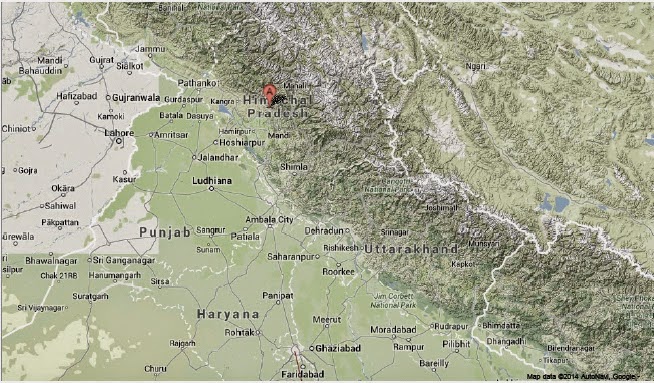Kimberlites are uncommon geological formations formed by the
extrusion of mantle material from deep within the Earth. Despite the relatively
small number of kimberlites known, they have been the subject of extensive
studies for many years, as they are the source of the deepest known rocks found
on the surface of the planet, frequently contain xenoliths of other material
that they have accumulated during their passage, and because they are the best
known source of diamonds for the mineral extraction industry. There are
generally considered to be three forms of kimberlites: Group I Kimberlites, the
best known form, associated with Archaean cratons (ancient pieces of the continental lithosphere, emplaced before 2500 million years ago) across the globe.
Group II Kimberlites (or orangeites), which have a different mineralogical and
chemical composition, and which were thought to be restricted to the
Kaapvaal Craton of Southern Africa, until recent discoveries in Russia and
India. Group III Kimberlites (or transitional kimberlites) were also thought to
be restricted to Southern Africa, but are now known from West Africa, South
America, Russia, Australia and India.
Recent discoveries of diamond-bearing Group II Kimberlites in the
Bastar Craton of central India have provoked considerable interest in Indian
Kimberlites, both for their commercial potential as sources of diamonds, and
due to their apparent relationship to the Deccan Traps Flood Basals, emplaced
at the end of the Cretaceous.
In a paper published in the journal Geoscience Frontiers on 19
December 2013, Chalapathi Rao of the Department of Geology at Banaras Hindu University, Bernd Lehmann of Mineral Resources at the Technical University ofClausthal, B.K. Panwar and Alok Kumar, also of the Department of Geology at Banaras
Hindu University and Datta Mainkar of the Directorate of Geology and Mining in
Raipur discuss the results of petrographical and geochemical study of samples
from the Tokapal Kimberlite in the Bastar Craton.
(A) Generalised geological map of India showing the
location of the Tokapal kimberlite in the Bastar craton, central India. The occurrence
of other lamproites and kimberlites in various cratons is also shown. CBF =
Chitradurga fault; CITZ = Central Indian tectonic zone; CUB = Cuddapah basin;
CB = Chhattisgarh basin; VB =Vindhyan basin; SMB = Singhbhum mobile belt; CIS =
Central Indian shear zone; W =Wajrakarur kimberlite field; R = Raichur kimberlite
field; Np = Narayanpet kimberlite field; T =Tokapal kimberlite; M =Mainpur kimberlite
field; Dv =Damodar valley; Mg = Majhgawan; S = Saptarshi; K = Khadka; N =
Nuapada; G =Garledinne; Vk = Vattikod; Kr = Krishna; Rd =Ramadugu. (B)
Geological setting of the Tokapal kimberlite system. Rao et al. (2014).
The Tokapal Kimberliteis a roughly saucer-shaped sheet of volcanic
rock 2.5 km wide in the Western Indrāvati Basin. It is one of the world’s
largest crater kimberlites, covering over 5.5 km2)
and being more than 50 m thick across much of its extent, exceeding 90 m in
places.
Tokapal tuff exposed in a pit. Rao et al. (2014).
The samples show little contamination by crustal material, but have
apparently been somewhat metamorphicly altered since they were emplaced,
showing low-temperature serpentinisation and carbonate alteration. This means
that of the three major mineral types in the rock (olivines, carbonates and
spinels) only the spinels are preserved in their original form. Garnierite is
present in the samples, apparently formed from the serpentinisation of olivine,
but diamonds are absent.
Back scattered electron (BSE) image of the Tokapal
pipe showing olivine macrocrysts (Ol), titanite (Ti) and spinel (Sp). Rao et al. (2014).
Despite this metamorphic influence, the proportions of major
elements is thought to have been preserved, enabling inferences to be made from
the bulk element composition. The Lanthanum-Ytterbium ratio of the samples are comparable
to those seen in the Wajrakarur and Narayanpet kimberlite fields in the south of
India, implying a common origin. Other element ratios show strong similarities
to those seen in Group II Kimberlites from Southern Africa and Central India,
and Group III Kimberlites from Southern India and Southern Africa.
The Tokapal, Wajrakarur and Narayanpet kimberlites, the Majhgawan diatreme
and the lamproites of the Cuddapah basin show similar depleted-mantle Neodymium ages (date obtained by comparing the ratio of Samarium147 to its decay product Neodymium143), implying a potential common origin, with the dates obtained
suggesting a possible link with the breakup of the ancient supercontinent of Columbia,
which formed between 2.0 and 1.7 billion years ago and lasted till about 1.3
billion years ago.
See also…
Palms are an important component of modern tropical ecosystems, with
the majority of species (~90%) restricted to tropical rainforests, where they
are important understory plants. Palms reach their...
A report in the Times of India on 6 June 2014 has documented a possible volcanic eruption in the
Kangra District of Himachal Pradesh State, India. The eruption...
Sixty-five million years ago the world was a very different place; the
land was dominated by giant dinosaurs, pterosaurs filled the skies and
the seas swarmed with giant marine reptiles and ammonites. Then
overnight (in geological terms) everything changed. The non-avian
dinosaurs disappeared, as did the pterosaurs, ammonites and all the
marine reptiles except turtles and sea-snakes (crocodiles have since...
Follow Sciency Thoughts on Facebook.






